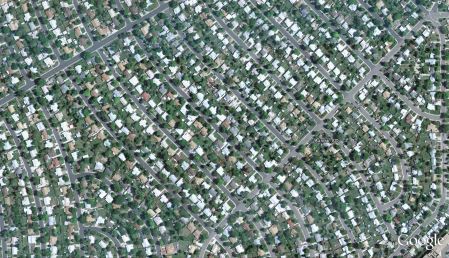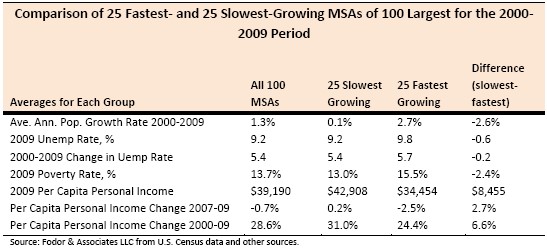A new study of growth and prosperity in American cities examines long-held beliefs about the benefits of growth. In Eben Fodor’s article, Relationship between Growth and Prosperity in 100 Largest U.S. Metropolitan Areas, the conventional wisdom that growth brings economic well-being is questioned. Here’s the money quote:
Most cities in the U.S. have operated on the assumption that growth is inherently beneficial and that more and faster growth will benefit local residents economically. This examination of the 100 largest metro areas, representing 66% of the total U.S. population, shows those that have fared the best have the lowest growth rates. Even metro areas with stable or declining populations tended to fare better than fast-growing areas.
This study compared income levels, unemployment rates, and poverty rates with growth rates for each metro area. In every category, faster-growing metro areas fared worse than slower growing areas. Residents of the 25 slowest-growing metro areas averaged $8,455 more personal income per capita than in the 25 fastest-growing areas. They also had lower unemployment and poverty rates. The nine-year study period captures the effects of the Great Recession, and changes from 2007 to 2009 show that faster-growing metro areas were more severely impacted.
And here is a summary of his findings:
Growth doesn’t bring bad news to everyone, however. According to Fodor, certain segments of the population do benefit from growth:
Growth clearly provides benefits to some elements of the local population (see Molotch, 1976; Logan, 1988; and Fodor, 2001). Foremost among these are the real estate, financial, and land development businesses. Growth generates demand for more housing and commercial space that these businesses build, sell, and finance. Higher demand increases real estate prices, commissions, and loan fees, and makes the development business more profitable. These business interests represent a wealthy and politically influential constituency in most cities that advocates in favor of increasing local growth. They are organized and represented through their local trade associations: the homebuilders’ association, the realtors’ association, the mortgage bankers’ association, and the local chamber of commerce.
While certain businesses prosper from growth, the balance of the community seems to suffer. The statistics showing that fast-growing areas tend to have lower and declining incomes, indicate that any gains by the businesses that directly benefit from growth are more than offset by losses to the balance of the local population. In other words, a small segment of the local population may benefit from faster growth, but the larger population tends to see their prosperity decline.
Hat tip to Al Bartlett for forwarding this study to the Blue Line.




